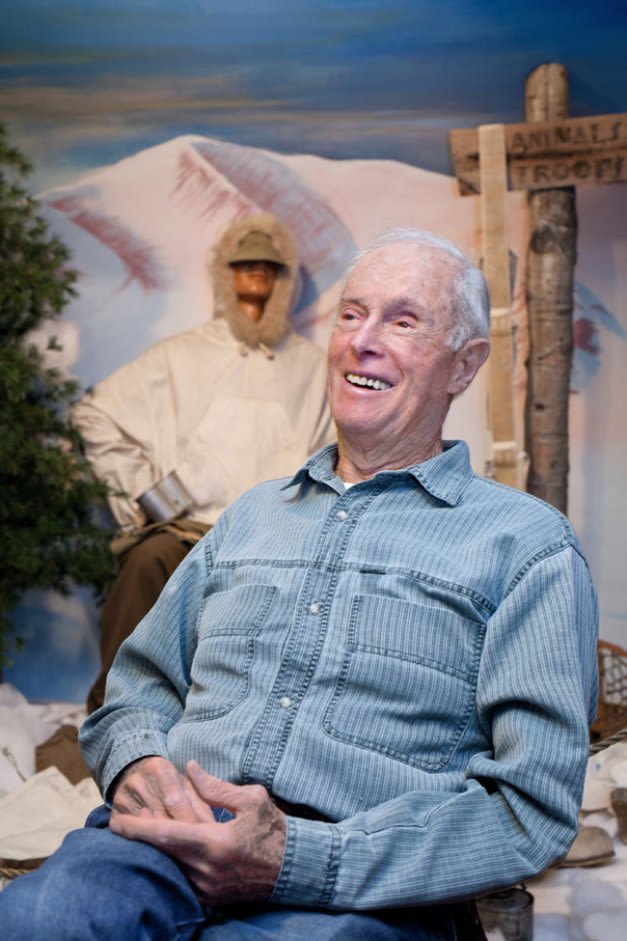Honoring the Legacy of Sandy Treat, A Vail Hero

Image: Kelly Lemon
Editor's note: Sandy Treat died on Sunday, September 1, 2019, at age 96.
For a guy in his 90s, a rugged ski racer who survived World War II and enjoyed a long, globe-hopping corporate career, Edwards’s Sandy Treat is a pretty amazing fellow. And as a living link to history at the Colorado Snowsports Museum in Vail Village, Treat’s Friday afternoon presentations on the storied 10th Mountain Division and its members’ impact on the American ski industry have become something of a staple for both history buffs and visitors.
“I had a couple of guys from the current division turn up this fall after getting back from Afghanistan, good guys but tough, and I asked them how long it would take them to knock out a group of volunteer soldiers like we were with the modern weapons they have,” Treat recalls. “They said, ‘About fifteen minutes.’ These soldiers today are professionals. We were just a bunch of kids.”
The tall and lanky Treat has appeared weekly for the past three years, offering colorful glimpses of his time as an 18-year-old college student–turned–volunteer enlistee for the division, which at the time (1943) used the mountainous surroundings of nearby Camp Hale to train 14,000 “skiing soldiers” for eventual duty in Italy.
Treat never forgot his time in the Colorado Rockies and returned to the Vail Valley twenty-seven years ago. “My first memory from January 1943 was seeing those snowcapped mountains of Colorado and thinking how great it was going to be,” he recalls. “So when I asked my wife, Barbara, where we should retire, maybe a little facetiously she said, ‘You know very well where you want to retire.’”
Age has never been much of an issue for Treat, who competed aggressively in masters ski racing until a terrible accident five years ago cost him an eye and required a Flight for Life evacuation to a Denver hospital. True to his resilient form, he was back on the slopes a year later, though he now recreates with the Foresight Ski Guides, facilitating skiing experiences for the visually impaired. At the request of his family, he also lets a local cowboy friend do the driving, but he remains as committed as ever to sharing his stories with museum visitors—be it two or 150 at a time.
Most Coloradans are familiar with the backstory of the 10th Mountain Division, so much so that many sport division-honoring specialty plates on their cars. Still, the rigors of high-altitude training and the horrors of the division’s illustrious campaign against the Germans only truly come to life when Treat’s there to tell the tale.
He’s quick to share a slightly myth-busting secret: “After more than a year of training, the army really didn’t quite know what to do with us, so we didn’t even bring our skis with us when we were assigned to Italy. But our rock-climbing, weapons, and tactical skills, and our endurance training, all turned out to be the key elements to our success.”
Treat’s storytelling skills sparkle as he talks about those many frozen months at Camp Hale, digging holes in the snow for overnight bivouacs in surprisingly warm 1940s-issue sleeping bags or gaining combat skills with mortars and machine guns. As a seasoned skier, Treat was able to help his fellow trainees with their skills on the slopes at what is now Ski Cooper.
“I’m 6-foot-2, and those 220 cm hickory skis were big even for me—and didn’t even have metal edges at first. Skiing was still in its embryonic form back then,” he recalls. “Some of the equipment was revolutionary, like our reversible jackets or the bear-trap bindings you could open up for climbing, and some wasn’t so great, like our leather boots, which froze solid when they were wet.”
Treat and his fellow trainees were eventually sent to Italy, where they waged an extensive campaign against a heavily fortified German division atop Monte Castello, alongside Brazilian troops. Key to the battle was a nighttime climb up a 2,000-foot cliff, old hat for the 10th Mountain boys, and their victory there opened a chance to push further north into German-held territory. “But we fought back and forth for three months, and it was very bloody: 1,000 deaths and 4,500 wounded on our side, which was a lot for a short time,” he says. “Eventually, the Germans knew they were losing the war, and then the Japanese surrendered after the atomic bombs were dropped.”
A native of the Northeast, Treat returned to Dartmouth on the GI Bill after the war, and upon graduation he began an extensive career with Canada’s Alcan Aluminum—including long stints living in Montreal, Geneva, and even Caracas (the cities, he proudly recalls, where his two daughters and son were born). He and his wife enjoyed their active retired life together in the valley until her death five years ago, and Treat says his volunteer work with the Ski Museum, where he is now a Hall of Fame member, is a way of continuing to give back to the community.
“I can’t say enough about this museum and what it’s done for the sport. It was my sport, my passion, and I consider it a privilege to be here.”






































